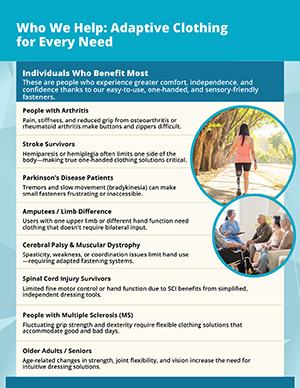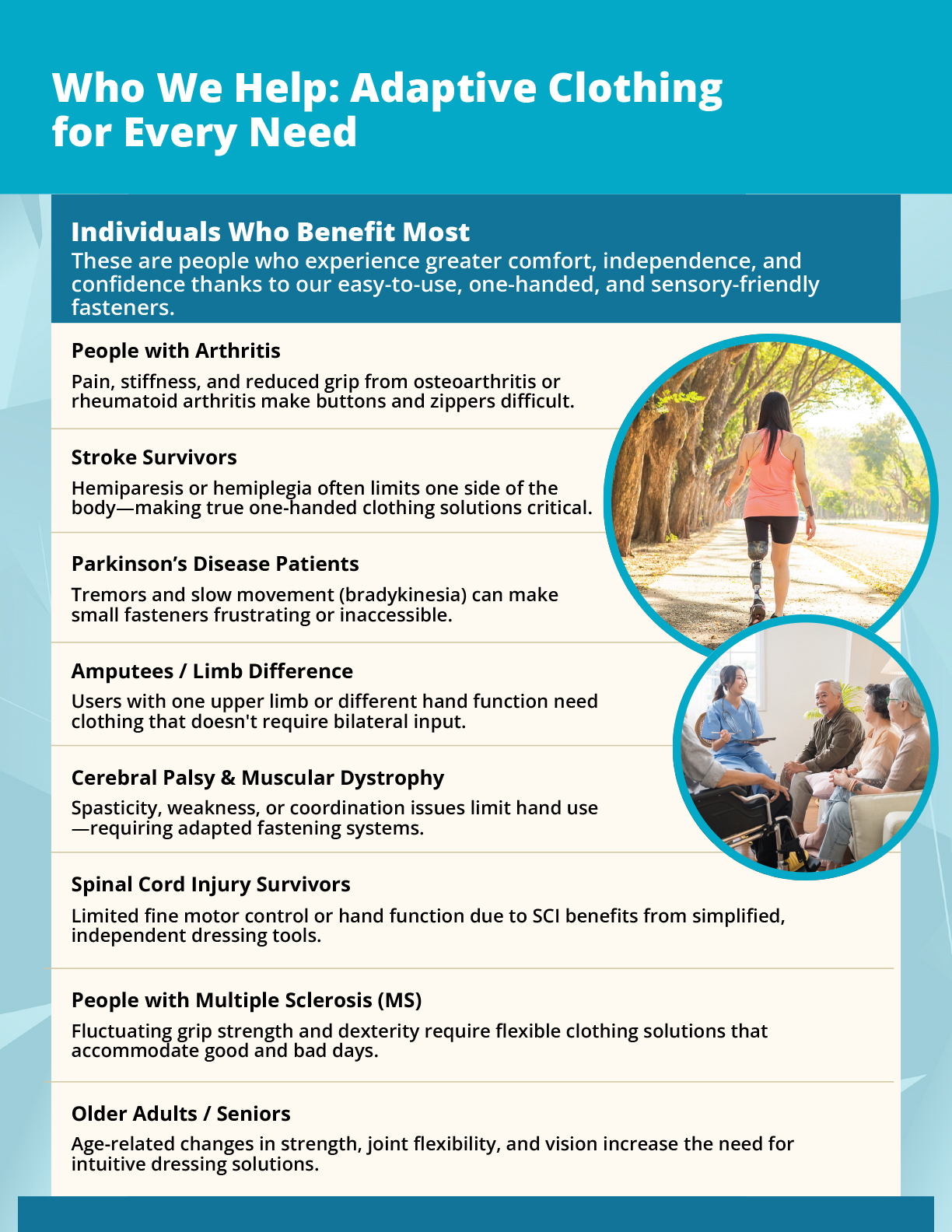Who We Help: Adaptive Clothing for Every Need
| Audience or Need | How LS Adaptive Helps |
|---|---|
| Limited dexterity/mobility Physical Disabilities | One-handed, intuitive fastening |
| Temporary injury or surgery Physical Disabilities | Easy dressing during recovery |
| Seniors/aging adults Physical Disabilities | Independence, comfort, and dignity |
| Limb difference Physical Disabilities |
Reduce steps for easier dressing |
| Sensory sensitivities Sensory Disabilities | Minimal tags, soft/stretch fabrics |
| Visual impairment Sensory Disabilities | Tactile cues, “homing” fasteners |
| Caregivers/family members Non-visible/Undiagnosed Disabilities | Reduced physical effort and stress |
| Clinical/institutional settings Emotional/Psychiatric Disabilities | Scalable, patient-friendly adaptive solutions |
| Inclusion-focused consumers Neurodiversity | Stylish, accessible clothing for all abilities |
Individuals Who Benefit Most
These are people who experience greater comfort, independence, and confidence thanks to our easy-to-use, one-handed, and sensory-friendly fasteners.
People with Arthritis
Pain, stiffness, and reduced grip from osteoarthritis or rheumatoid arthritis make buttons and zippers difficult.
Stroke Survivors
Hemiparesis or hemiplegia often limits one side of the body—making true one-handed clothing solutions critical.
Parkinson's Disease Patients
Tremors and slow movement (bradykinesia) can make small fasteners frustrating or inaccessible.
Amputees / Limb Difference
Users with upper limb difference or limited dexterity need clothing that doesn't require bilateral input.
Cerebral Palsy & Muscular Dystrophy
Spasticity, weakness, or coordination issues limit hand use—requiring adaptive fastening systems.
Spinal Cord Injury Survivors
Limited fine motor control or hand dexterity due to SCI - individuals benefit from simplified, independent dressing tools.
People with Multiple Sclerosis (MS)
Fluctuating grip strength and dexterity require flexible clothing solutions that accommodate good and bad days.
Older Adults / Seniors
Age-related changes in strength, joint flexibility, and vision increase the need for intuitive dressing solutions.
Other Disability Communities
Autism / Sensory Sensitivities
Soft fabrics, tagless designs, and smooth fasteners reduce sensory overload during dressing.
Visual Impairment
Tactile cues and fasteners that align without sight (e.g., magnetic or guided) to support independence.
Essential Tremor
Unsteady hands benefit from larger or simplified fasteners instead of zippers or small buttons.
Acute and Alternate Users
Injury Recovery
People healing from fractures or sprains often can’t use one hand—one-handed dressing becomes essential.
Post-Surgical Patients
Shoulder or hand surgeries can temporarily prevent normal dressing—adaptive clothing aids recovery.
Women who are Pregnant/Postpartum
Reduced range of motion or C-section limitations call for easier, more comfortable clothing options.
Occupational Needs
Occupational Needs
Workers needing rapid garment changes or PPE (healthcare, EMS, fire) benefit from fast, one-handed closures.
Caregiving & Institutional Markets
Hospitals & Rehab Centers
Stocking adaptive apparel improves patient experience and post-op recovery.
Family Caregivers
Adaptive clothing supports loved ones while easing the physical burden of dressing assistance.
Professional Caregivers
Efficient dressing means less time and physical strain per patient—lowering injury risk for staff.
Rehabilitation Clinics / OTs
Fasteners that support therapy goals like independence and functional motion.
Assisted Living & Long-Term Care
Supports dignity and autonomy for residents who may struggle with dressing.
Lifestyle & Inclusion Segments
Retailers of Adaptive Products
Expanding offerings with innovative, stylish, functional adaptive clothing.
Disability-Oriented Nonprofits & Advocates
Endorsing and distributing accessible products aligned with their mission.
Institutional Buyers
Adaptive Sports Participants
Athletes who need activewear with fast, functional dressing options.
Inclusive Fashion Consumers
Buyers seeking style that supports accessibility—normalizing adaptive designs.
Universal Design Shoppers
People of all ages who prefer smart designs that works for everyone—today or in the future.

